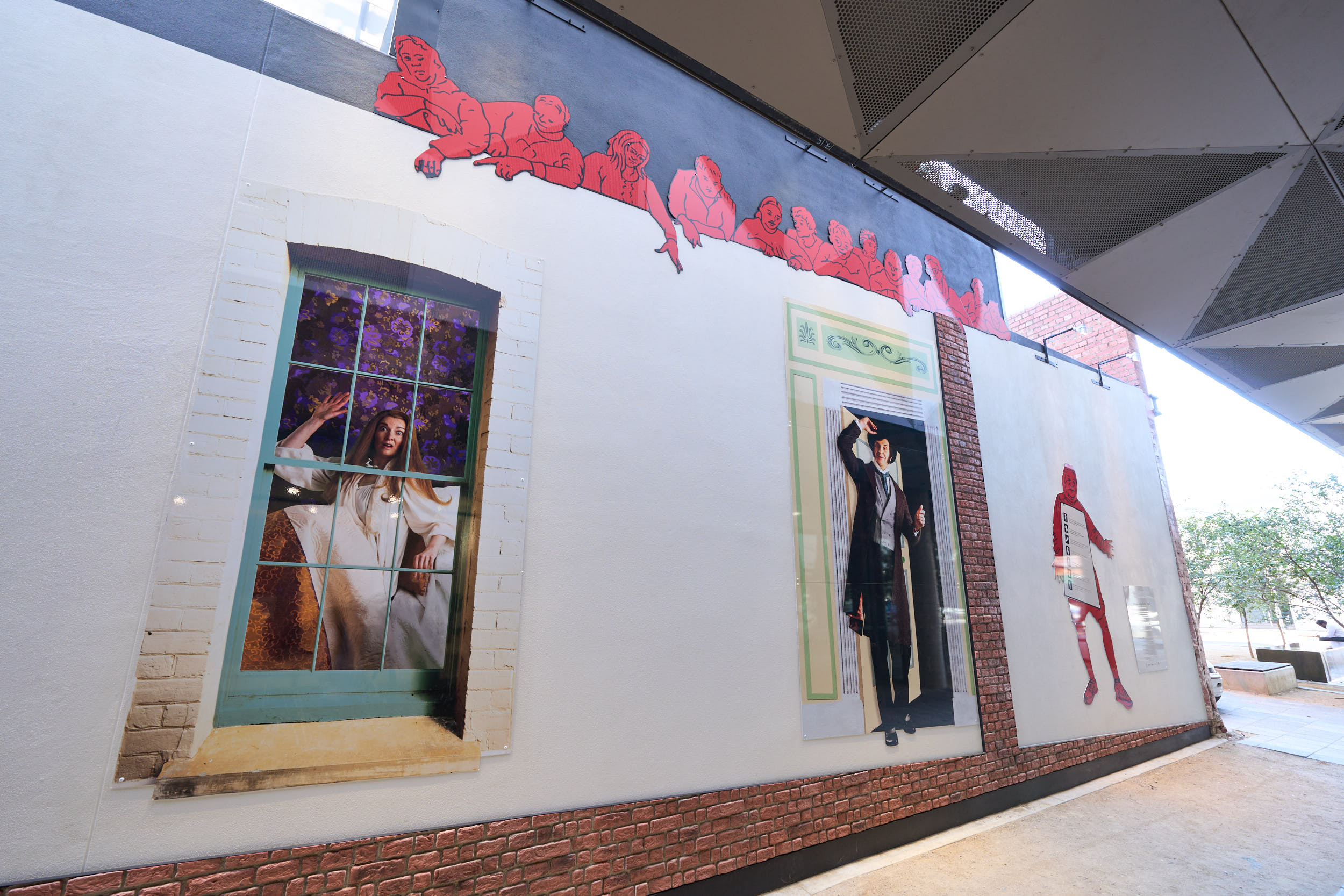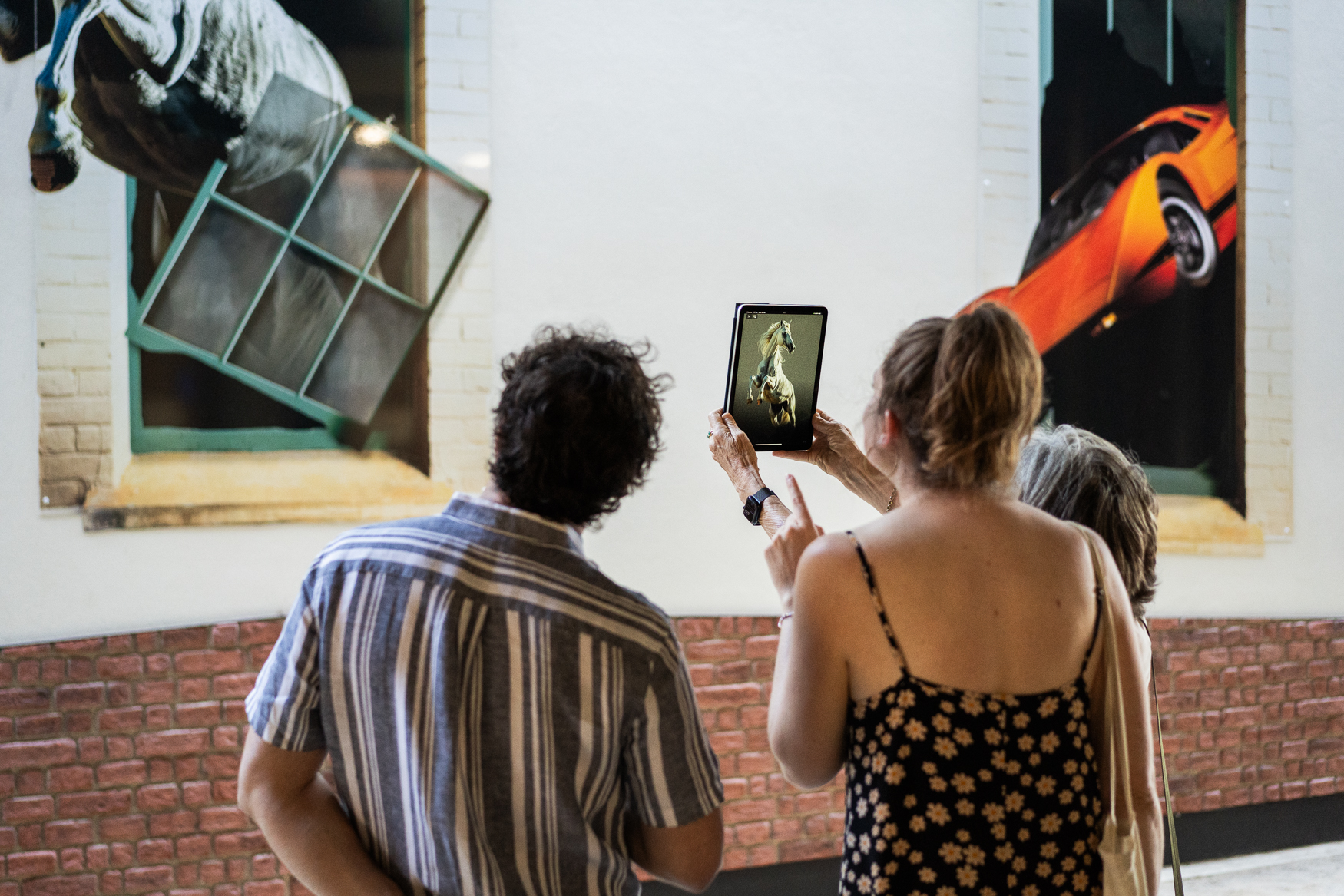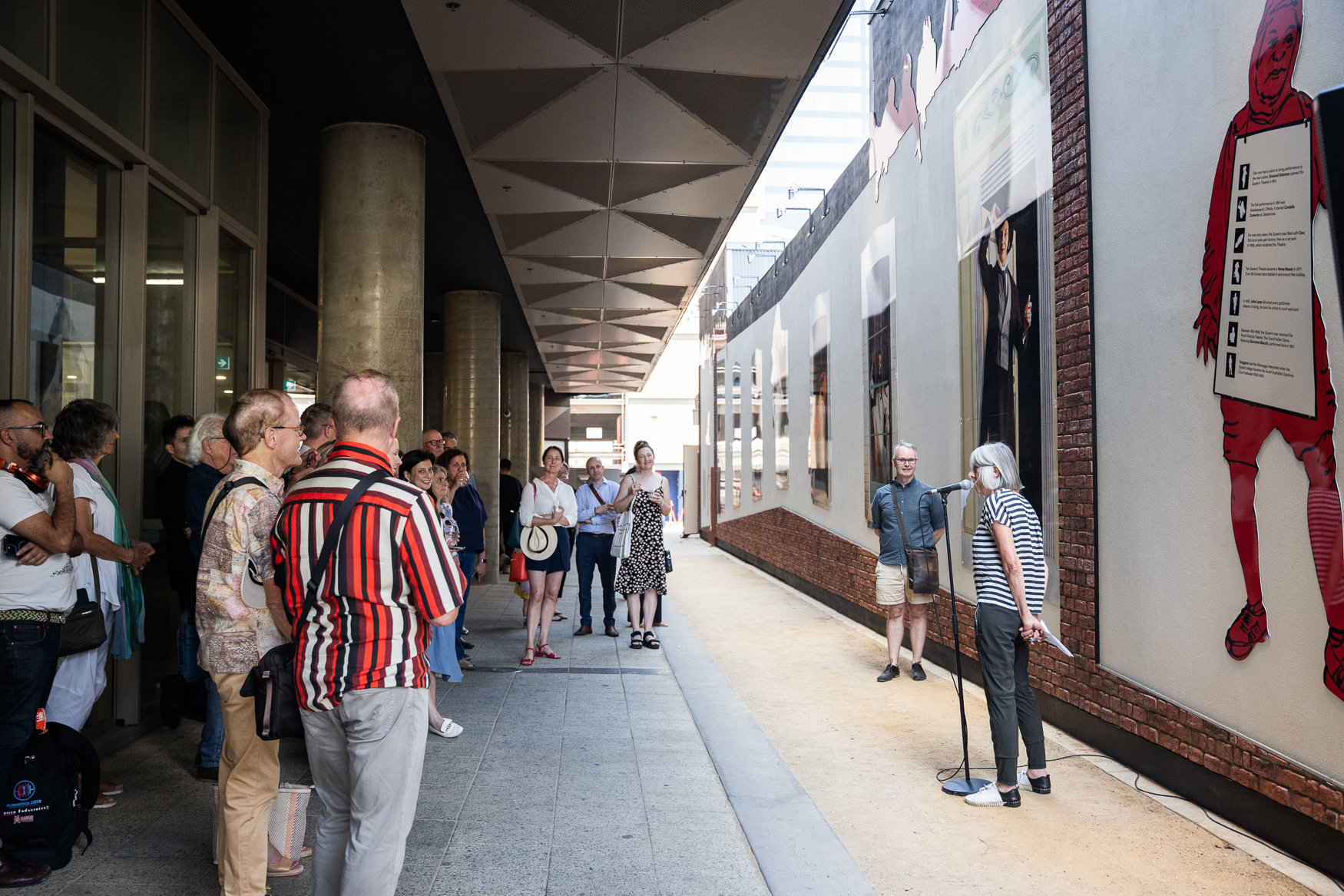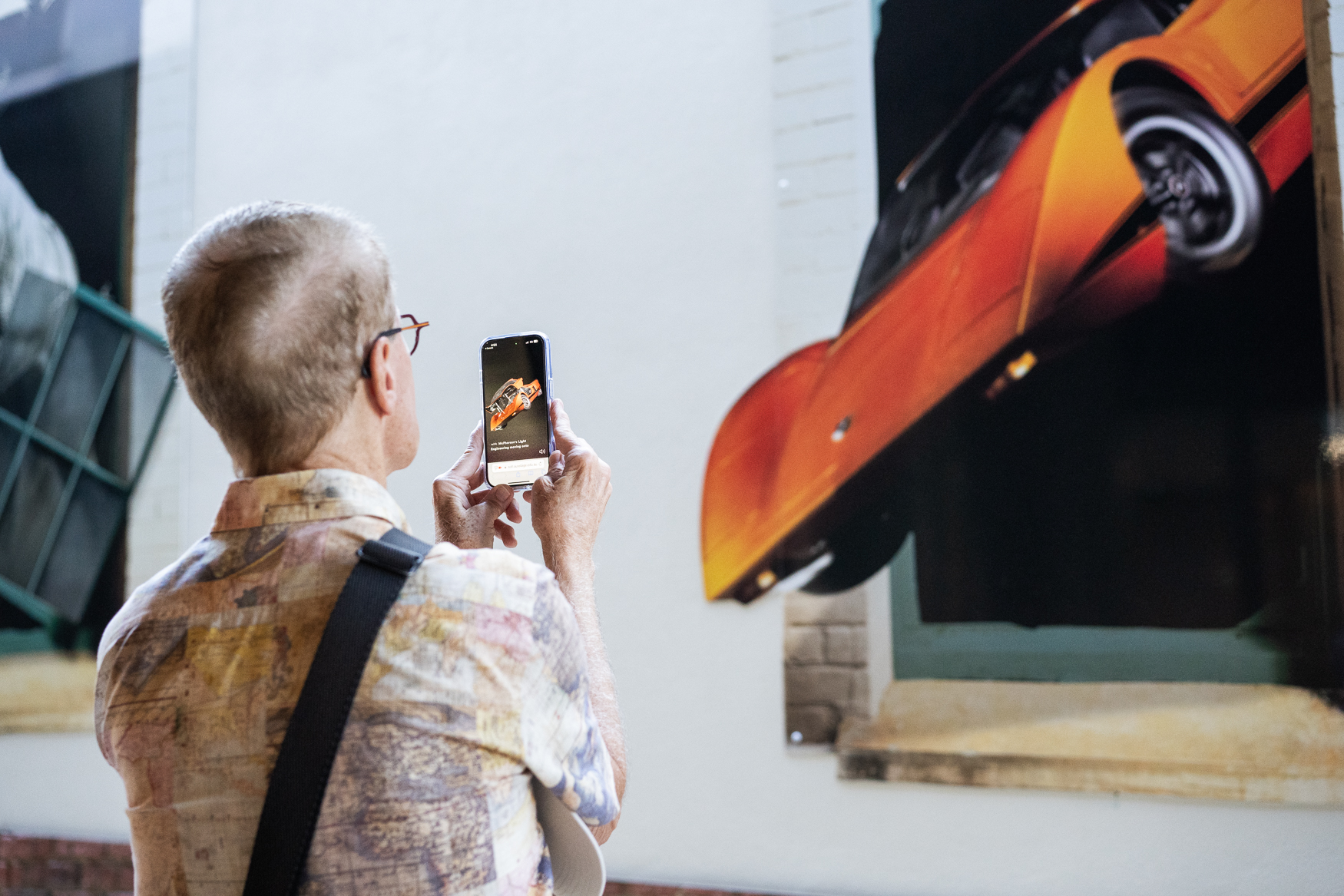Image: Mary Moore and Sandpit, The Queen’s Wall. Photograph Lana Adams.
Adelaide’s historic Queen’s Theatre has been brought to life in a new and innovative way with the unveiling of The Queen’s Wall , a stunning 32-metre artwork created by acclaimed visual artist Mary Moore in collaboration with interactive media specialists Sandpit.
Commissioned by the Department of the Premier and Cabinet, and delivered by Guildhouse, this intermedial artwork transforms the western exterior of the city’s oldest heritage theatre and tells its rich and varied history through a blend of traditional design and modern technology.
As the oldest mainland theatre in Australia that is still in use, the Queen’s Theatre stands as a testament to Adelaide’s vibrant cultural heritage. Drawing on over a decade of research, the artwork encapsulates seven pivotal stories from the Queen’s Theatre’s fascinating timeline, offering a vibrant visual journey through its many incarnations. From its grand opening in 1841 by Emanuel Solomon to its time as a Horse Bazaar and even a car park, the Queen’s Theatre has stood witness to nearly two centuries of Adelaide’s cultural evolution.
Highlights of the artwork include:
- The Opening in 1841: The first performance was Shakespeare’s Othello, starring Cordelia Cameron as Desdemona.
- Supreme Court Sessions: From 1843 to 1850, the stage was repurposed for South Australia’s Supreme Court, with Yanggara serving as the Narrunga interpreter.
- The First Court Case on Theatre Censorship: In 1851, John Lazar did what every performer dreams of doing… he took the critics to court and won!
- The Royal Victoria Theatre: Between 1851 and 1868, the Queen’s was renamed the Royal Victoria Theatre. The Grand Italian Opera, featuring Giovanna Bianchi, performed there in 1861.
- Theatre to Horse Bazaar: In 1877, the Queen’s Theatre transitioned to stabling over 165 horses.
- Artistic Reclamation: After decades as a car park, artists reclaimed the space in 1996.
To enhance this dynamic retelling of history, Sandpit has developed an interactive App. By scanning the mural with their mobile devices, visitors can bring the figures on the Queen’s Wall to life, explore the interior of the theatre as it appeared during each historical moment, and enjoy immersive audio scenes or imagined interviews with the artwork’s featured characters.
Mary Moore remarked, “The Queen’s Wall is a journey through time and space, inspired by my passion for spatial theatre design. I envisioned it as a vibrant reflection of a theatre community, brought to life through the collective creativity of many talented artists. It’s a living dialogue between the past and present.”
Over thirty freelance artists, four digital companies and two creative organisations have contributed to the making of this experience, and a further five performing arts companies have provided moving images for inclusion in the App.Over ten years of archival research informs the stories embedded in the design and the visualisation of the past interiors now accessible through the App.
Finally, over 460 artists have performed in the Queen’s since it was reclaimed as a theatre in 1996.
The Queen’s Wall offers a unique blend of art, history, and technology, ensuring the stories of this iconic venue continue to captivate audiences for generations to come.
Images: Mary Moore and Sandpit, The Queen’s Wall. Photographs Sam Roberts and Lana Adams.

About Mary Moore
Mary Moore was one of the youngest members of UK team that won the Gold Triga at the 4th Prague Quadrennial International Theatre Design Exhibition (1979). Since that early success, her set and costume designs have been seen by audiences on four continents. She trained at the London Central St Martin’s School of Art, where she received a grounding in the European modernist tradition which has lived on in her designs for major UK and Australian theatre, opera, and dance companies. In contrast, her experimental research has led to ground-breaking site-specific, interactive and promenade performance; an installation practice; and even interactive museum design.
She was supported by a two-year Australian Council fellowship to make two intercultural Australian/Japanese performance works commissioned and presented by the Adelaide, Perth, Shanghai, and the Sydney Spring festivals. Her work has been the subject of major academic publications (Cambridge University Press, Routledge, Rodopi, Palgrave Macmillan). Recently she completed two commissions to design virtual reality immersive environments for AusStage, the Australian National Performing Arts Database, and the Centre of Ibsen Studies, University of Oslo. Moore has a Star on the Adelaide Festival Centre Walk of Fame and has received a Premier’s Lifetime Achievement Award.
About Sandpit
Sandpit is an award-winning experience design studio creating inspiring, inclusive, one-of-a-kind experiences to every stage of the design process; from master planning to design, install, and beyond. Working closely with clients to gain a deep understanding of the stories they want to tell, Sandpit brings that vision to life with spectacular interactives and immersive environments.
With an team of designers, developers, artists, and storytellers Sandpit have created visitor experiences for ACMI, Museums Victoria, National Gallery of Victoria, Reece Group, the National Museum of Australia, Melbourne Holocaust Museum, the National Sports Museum, Back to Back Theatre, Australian Children’s Television Foundation, Art Science Museum Singapore and Shakespeare’s Birthplace Trust in Stratford-Upon-Avon.
Award Nomination
This artwork was nominated for the City of Adelaide Prize within the South Australian Architecture Awards Program 2025. This program recoginises innovatice projects that enliven the City’s public spaces and engage with the communty.
Guildhouse Professional Services
Harness South Australian creative excellence.
Guildhouse offers a range of customisable professional services to support organisations and individuals to engage with South Australia’s exceptional artists, craftspeople, and designers.
As the peak industry body for professional visual art and contemporary craft in South Australia, Guildhouse has contributed to a vibrant artistic community for over 59 years. We are trusted for our deep understanding of artistic practice, sector knowledge, unique networks and a highly experienced team. Guildhouse works with over 1200 artists from diverse artistic practices.





